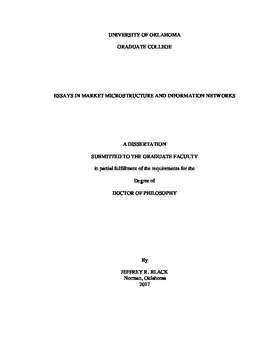| dc.description.abstract | This dissertation is a collection of three essays which study the impact of make-take fees on market efficiency, the relevance of three dimensions of liquidity on bond yields, and the value of information flow through the network of corporate directors.
In Chapter 1, I investigate the causal link between exchange-subsidized liquidity, in the form of make-take fees, and market efficiency. Using an exogenous experiment performed by NASDAQ in 2015, I employ difference-in-differences analysis on a matched sample and find that a decrease in take fee and make rebate levels leads to greater absolute pricing error and larger variance of mispricing. This stems from widened bid-ask spreads and decreased informed trading by retail investors. These findings demonstrate that make-take fees are beneficial for market efficiency.
There are three important dimensions of liquidity: trading costs, depth, and resiliency. Chapter 2 investigate the relevance of each of these three dimensions of liquidity – separately and in conjunction – for the pricing of corporate bonds. Unlike previous studies, this sample allows us to cleanly separate the default and non-default components of yield spreads. We find that each of the above three dimensions of liquidity are priced factors. Overall, in our sample, a one standard deviation change in trading costs, resiliency, and depth measures lead to a change in non-default spreads of 5.00 basis points, 2.27 basis points, and 1.27 basis points, respectively. We also find that both bond-specific and market-wide dimensions of liquidity are priced in non-default spreads. Finally, we find that there does exist in some periods a small residual non-default yield spread that is consistent with an additional “flight-to-extreme-liquidity” premium reflecting investor preference for assets that enable quickest possible disengagement from the market when necessary.
Chapter 3 investigates the value of information flow through the network of corporate directors. More connected directors may have better information and more influence, which can increase firm value. However, directors with larger networks may also spread misleading or value-decreasing management practices. To identify the effect of director networks on firm value, we use the sudden deaths of well-connected directors as a shock to the director networks of interlocked directors. By looking at the announcement returns and using a difference-in-differences methodology, we find that this negative shock to director networks reduces firm value. This evidence suggests that director networks are valuable. | en_US |
